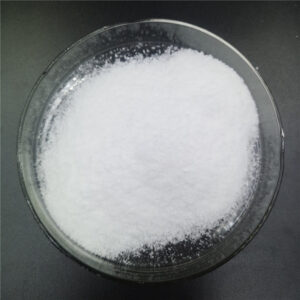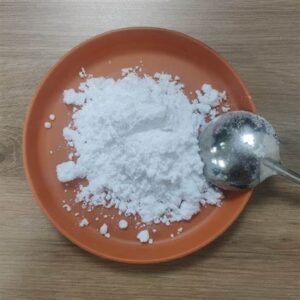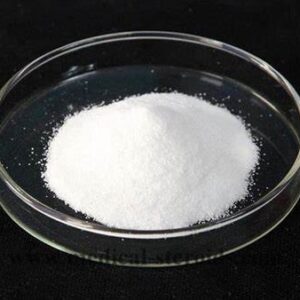Sell Copper chromite Cas 1205-53-18-8
Sell Copper chromite Cas 1205-53-18-8
Description générale
Application
INFORMATIONS SUR LA SÉCURITÉ
Pictograms
Mention d’avertissement
Danger
Mentions de danger
Conseils de prudence
Classification des risques
Aquatic Acute 1 – Aquatic Chronic 1 – Ox. Sol. 2 – STOT SE 3
Organes cibles
Respiratory system
Code de la classe de stockage
5.1B – Oxidizing hazardous materials
WGK
WGK 3
Flash Point(F)
Not applicable
Point d’éclair C
Not applicable
Équipement de protection individuelle
dust mask type N95 (US), Eyeshields, Faceshields, Gloves, type P3 (EN 143) respirator cartridges
Copper chromite is an inorganic compound with the formula Cu2Cr2O5. It is a black solid that is used to catalyze reactions in organic synthesis.[3]
History of Copper chromite
The material was first described in 1908.[4] The catalyst was developed in North America by Homer Burton Adkins and Wilbur Arthur Lazier, partly based on interrogation of German chemists after World War II in relation to the Fischer–Tropsch process.[5][6] For this reason it is sometimes referred to as the Adkins catalyst or the Lazier catalyst.
Chemical structure of Copper chromite
The compound adopts a spinel structure. The oxidation states for the constituent metals are Cu(II) and Cr(III).[7] A variety of compositions are recognized for the substance, including Cu2CrO4·CuO·BaCrO4 (CAS# 99328-50-4) and Cu2Cr2O5 (CAS# 12053-18-8). Commercial samples often contain barium oxide and other components.
Production of Copper chromite
Copper chromite is produced by thermal decomposition of one of three substances. The traditional method is by the ignition of copper chromate:[8]
- 2 CuCrO
4 → 2 CuCrO
3 + O
2
Copper barium ammonium chromate is the most commonly used substance for production of copper chromite. The resulting copper chromite mixture produced by this method can only be used in procedures that contain materials inert to barium, as barium is a product of the decomposition of copper barium ammonium chromate, and is thus present in the resulting mixture. The by-product copper oxide is removed using an acetic acid extraction, consisting of washing with the acid, decantation and then heat drying of the remaining solid to yield isolated copper chromite. Copper chromite is produced by the exposure of copper barium ammonium chromate to temperatures of 350-450 °C, generally by a muffle furnace:[5]
- Ba
2Cu
2(NH
4)
2(CrO
4)
5 → CrCuO
3 + CuO + 2 Ba + 4 H
2O + 4 Cr + N
2 + 6 O
2
Copper ammonium chromate is also used for production of copper chromite. It is generally utilized as an alternative to the route of barium ammonium chromate for usage in chemicals reactive with barium. This can also be washed with acetic acid and dried to remove impurities. Copper chromite is produced through the exposure of copper ammonium chromate to temperatures of 350-450 °C:
- Cu(NH
4)
2(CrO
4)
2 → CrCuO
3 + CrO + 4 H
2O + N
2
An active copper chromite catalyst which includes barium in its structure can be prepared from a solution containing barium nitrate, copper(II) nitrate, and ammonium chromate. When these compounds are mixed a resulting precipitate is formed. This solid product is then calcined at 350–400 °C to yield the catalyst:[8]
- Cu(NO3)2 + Ba(NO3)2 + (NH4)2CrO4 → CuCr2O4·BaCr2O
- Sell Copper chromite Cas 1205-53-18-8
- Sell Copper chromite Cas 1205-53-18-8
- Sell Copper chromite Cas 1205-53-18-8
- Sell Copper chromite Cas 1205-53-18-8
- Sell Copper chromite Cas 1205-53-18-8
- Sell Copper chromite Cas 1205-53-18-8
- Sell Copper chromite Cas 1205-53-18-8
- Sell Copper chromite Cas 1205-53-18-8
CAS 12053-18-8 | SCBT – Santa Cruz Biotechnology
WebBuy Copperchromite Catalyst (CAS 12053-18–8), a product for proteomics research, from Santa Cruz. Molecular Formula: 2CuO ⋅ Cr2O3, MW: 311.08
-
CAS: 12053-18-8 – Copper chromite | CymitQuimica
WebCAS: 12053-18–8 Formula: Cr 2 CuO 4 Purity: 46% Color and Shape: Solid Molecular weight: 231.5358 Ref: AN-AG0075O5 Estimated delivery in United States, on Friday 8 …
-
CAS 12053-18-8 Copper Chromite – Alfa Chemistry
WebCopper Chromite Structure CAS 12053-18–8 Synonyms COPPER (II) CHROMITE;COPPERCHROMIUM OXIDE;COPPER CHROMITE …
-
Copper chromite supplier distributor- CAS 12053-18-8 – Parchem
WebProduct Description PRODUCT Copper chromite CAS # 12053-18–8 SYNONYM Copper chromite;Copper chromium oxide FORMULA Cr2Cu2O5 Typical Product Specifications …
-
CAS No.12053-18-8,COPPER CHROMITE Suppliers – LookChem
WebFind quality suppliers and manufacturers of 12053-18-8(COPPER CHROMITE) for price inquiry. where to buy 12053-18-8(COPPER CHROMITE).Also offer free database of …
-
CAS 12053-18-8 Copper Chromite – Catalysts / Alfa Chemistry
WebAlfa Chemistry offers Copper Chromite (12053-18–8) for experimental / research use. View information & documentation regarding Copper Chromite, including CAS, structure & …
-
Copper chromite supplier | CasNO.12053-18-8 – LookChem
WebThe Oxocopper; oxo-(oxochromiooxy)chromium, with its CAS registry number 12053-18-8, has the molecular foumula of Cr 2 Cu 2 O 5 and the formula weight of 231.54. This is a …
-
Copper Chromite(CAS:12053-18-8) – amitychem.com
Copper Chromite(CAS:12053-18-8) INQUIRY. BASIC INFO. Contact us for more details of our high quality Copper Chromite(CAS:12053-18-8). Amitychem Corporation will be …




Reviews
There are no reviews yet.